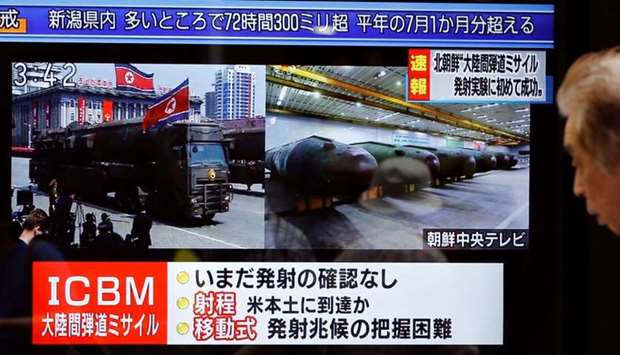* N.Korea says it tested intercontinental ballistic missile
* N.Korea says its missiles can hit anywhere on Earth
* Missile launch comes just days ahead of G20 summit
* Japan's Abe says N.Korea ignoring repeated warnings
* Trump: ‘Perhaps China will put a heavy move on North Korea’
North Korea said on Tuesday it successfully test-launched an intercontinental ballistic missile (ICBM), which flew a trajectory that an expert said could allow a weapon to hit the US state of Alaska.
The launch comes days before leaders from the Group of 20 nations are due to discuss steps to rein in Pyongyang's weapons programmes, which the North has pursued in defiance of UN Security Council and unilateral US and South Korean sanctions.
The launch, which North Korea's state media said was ordered and supervised by leader Kim Jong Un, sent the rocket 933 km (580 miles) with a flight time of 39 minutes and reached an altitude of 2,802 km.
Earlier on Tuesday, officials from South Korea, Japan and the United States said the missile had landed in Japan's Exclusive Economic Zone (EEZ) after being launched near an airfield in Panghyon, about 100 km (60 miles) northwest of the North's capital, Pyongyang.
‘The test launch was conducted at the sharpest angle possible and did not have any negative effect on neighbouring countries,’ North Korea's state media said in a statement.
The North also said its missile capability could now strike anywhere in the world.
South Korean President Moon Jae-in, who convened a national security council meeting, said the missile was believed to be an intermediate range type, but the military was also looking at the possibility it was an intercontinental ballistic missile (ICBM).
NUCLEAR-TIPPED ICBM
North Korea has been working to develop a nuclear-tipped ICBM capable of hitting the United States, ignoring repeated warnings from the international community.
Japan's Prime Minister Shinzo Abe said on Tuesday he will ask the presidents of China and Russia to play more constructive roles in efforts to stop the Pyongyang's arms programme.
‘Leaders of the world will gather at the G20 meeting. I would like to strongly call for solidarity of the international community on the North Korean issue,’ Abe told reporters.
Stock markets in both South Korea and Japan fell after the missile launch, with the Kospi ending down 0.6 percent and Japan's Nikkei share average ending down 0.1 percent.
Japan said on Monday the United States, South Korea and Japan will have a trilateral summit on North Korea at the G20. China's leader Xi Jinping will also be at the July 7-8 meeting in Hamburg, Germany.
North Korea has conducted four missile tests since South Korean President Moon Jae-in took office in May, vowing to use dialogue as well as pressure to bring Pyongyang's nuclear and missile programmes under control.
US President Donald Trump, responding to the latest launch, wrote on Twitter: ‘North Korea has just launched another missile. Does this guy have anything better to do with his life?’ an apparent reference to North Korean leader Kim Jong Un.
‘Hard to believe South Korea and Japan will put up with this much longer. Perhaps China will put a heavy move on North Korea and end this nonsense once and for all!’, Trump said in a series of tweets.
White House officials said Trump has been briefed on the latest launch, which took place hours before Independence Day celebrations in the United States. North Korea has previously fired missiles around this holiday.
VERY HIGH TRAJECTORY
Pyongyang has conducted missile-related activities at an unprecedented pace since the start of last year. Analysts say it is years away from having a nuclear-tipped ICBM.
But Pyongyang is also trying to develop intermediate-range missiles capable of hitting US bases in the Pacific. The last North Korean launches before Tuesday were of land-to-sea cruise missiles on June 8.
David Wright, co-director of the Global Security Program at the US-based Union of Concerned Scientists, said the assessments of the flight time and distance suggest the missile might have been launched on a ‘very highly lofted’ trajectory of more than 2,800 km.
The same missile could reach a maximum range of roughly 6,700 km on a standard trajectory, Wright said in a blog post.
‘That range would not be enough to reach the lower 48 states or the large islands of Hawaii, but would allow it to reach all of Alaska,’ he said. (Graphic on North Korea's missile capabilities http://tmsnrt.rs/2t0oSv7)
North Korea is banned from testing or developing missiles under a series of UN resolutions.
It has conducted nuclear and missile tests to show defiance in the face of international pressure and to raise the stakes when Pyongyang sees regional powers getting ready for talks or sanctions, analysts say.
South Korea's Moon said on Monday in a meeting with former US president Barack Obama that North Korea now faces its ‘last opportunity’ to engage in talks with the outside world.
Earlier this week, North Korea was a key topic in phone calls between US President Donald Trump and the leaders of China and Japan. Leaders of both Asian countries reaffirmed their commitment to a denuclearised Korean Peninsula.
Trump has recently suggested he was running out of patience with China's modest steps to pressure North Korea.
In his meeting in Washington on Friday with Moon, Trump called on regional powers to implement sanctions and demanded that North Korea ‘choose a better path and do it quickly’.



